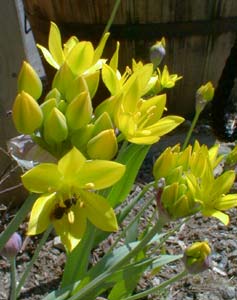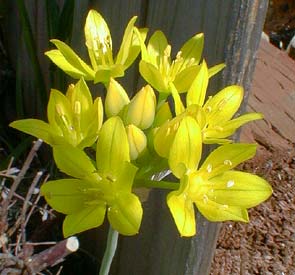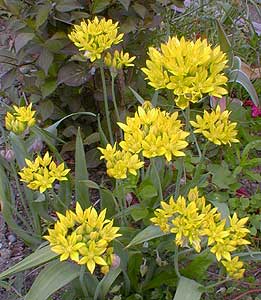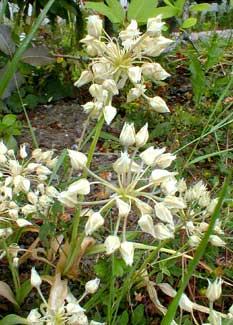
Golden Garlic; or,
Yellow Flowering Onion; or,
Lily Leek
"The child who threw away leaf after leaf of the many-coated onion, to get to the sweet heart, found in the end that he had thrown away the heart itself."
-Scented Leaves from a Chinese Jar,
Allen Upward,
1863-1926
Allen Upward,
1863-1926
During a close-out sale we got a bag of Allium moly luteum & planted them way later than is ideal. They were left-over stock & we hand-selected each bulb to avoid the moldy or shrivelled ones.
We took them right home & popped them in the ground in January (2003), out by the alley where they get no particular attention at any time of the year.
 They're supposed to be put in the ground in Autumn, but our mild seasons permit some leeway, & these maltreated bulbs did just fine, in full bud for April, blooming their hearts out in May (2003).
They're supposed to be put in the ground in Autumn, but our mild seasons permit some leeway, & these maltreated bulbs did just fine, in full bud for April, blooming their hearts out in May (2003).We liked them so much that following autumn we added ten more bulbs to a streetside sun-garden, so that we would have them in two locations for 2004; the third photo is of the second patch. This area got occasional watering & as a result the yellow yellow garlic flowers were larger.
This native of southern Europe prefers full sun, gets by in light shade, or in much hotter climates than ours may prefer a bit of afternoon shade. It's not fussy about soil conditions, though rich & loamy is best.
Ours are growing respectively in very dry & rather dry areas, but they would also do well in a regularly watered garden just so long as drainage is excellent & they do not long remain wet.
 It's very cold-hardy & does nicely down to zone 3, but is not heat-hardy & may not survive above zone 8 without protection during the hottest days. In areas where the ground freezes, our late planting of our first patch wouldn't've succeeded; the bulbs would need to go into the ground before the freezing starts.
It's very cold-hardy & does nicely down to zone 3, but is not heat-hardy & may not survive above zone 8 without protection during the hottest days. In areas where the ground freezes, our late planting of our first patch wouldn't've succeeded; the bulbs would need to go into the ground before the freezing starts.The Golden Lily Leek or flowering onion naturalizes both by producing offsets & self-seeding. It will colonize an area without being invasive. But if one wishes to limit their spread, removing the spent flowers before they go to seed means it will reproduce in-place by offsets only & not spread to any distance. It is generally resistant to deer, & squirrels won't dig up the bulbs.
 Despite that it is not widely regarded as a good kitchen onion, in reality there is nothing wrong with it. The leaves, flowers, & bulb are all edible, barring a specific allergy to onions & garlics. The bulbs are very small & taste like the mildest garlic.
Despite that it is not widely regarded as a good kitchen onion, in reality there is nothing wrong with it. The leaves, flowers, & bulb are all edible, barring a specific allergy to onions & garlics. The bulbs are very small & taste like the mildest garlic.Even if one doesn't wish to eat one's ornamental onion bulbs because they're better left as flowers, the leaves can be cut for kitchen use especially cooked, & with enough flowers to spare, young yellow blossoms make an edible decoration in salad.
I frankly don't care for the sorts of alliums that have enormous globe flowers five feet in the air, but this small allium is much prettier than that, more like a tiny lily. It blooms on stems nine to fifteen inches tall rising between pairs of knife-shaped leaves.
These long-lasting intensely yellow "umbels" or clusters of blossoms occur in May & June. The green "onion dome" buds are already decorative before flowering begins.
The blossoms are good for bouquets, though when bruised it does smell of onion, which can effect their acceptability indoors.
When they go to seed late in June, the flowerheads turn milky white & papery, & continue to be ornamental into July. Or if gathered at just the right moment, they can be saved for dry flower arrangement. The final photograph shows the yellow lily-leek in full seed. It can easily colonize its area over time, without ever being aggressive.